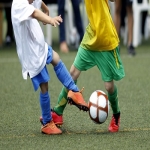What Is It?
Sever’s Disease (calcaneal apophysitis) is a common cause of heel pain in children and adolescents. This typically occurs in children who participate in running and jumping sports- for example basketball, volleyball, or gymnastics.

They will usually complain of pain throughout the heel, which may be accompanied by redness or swelling. These kids experience discomfort because of inflammation at the growth plate, which is at the back of the heel near the attachment of the Achilles tendon. As a result, these symptoms usually occur just before or during a growth spurt.
This rapid growth change causes stress at the growth plate, and is made worse by repetitive impact, as would be expected with athletic activity. It should be noted that flat shoes may also contribute to the symptoms in children who are not actively involved in athletic activities.

Treatment
The treatment for Sever’s Disease is based on controlling the symptoms, as there is no “cure” for this while the child is still growing. Activity modification, which can mean taking a period of weeks to months off from all athletic activity may be needed. Once symptoms have reduced enough to allow the child to return to increased activity, it is usually safe to do so. A calf/Achilles tendon stretching program is also a mainstay of treatment in order to help relieve stress. Ice and NSAIDs can also help with pain and swelling.

Furthermore, heel cups can help to give a cushioning effect to areas of discomfort. Alternatively, shoes with a slightly elevated heel may also help.
In cases of extreme pain, or when symptoms cannot be resolved with more conservative measures, a period of time in a walking boot may be required.
Unlike some other orthopedic conditions, surgical intervention is not indicated for Sever’s Disease.
Outcome

Recurrences of symptoms are common once a child has resumed normal activities, however, a continued stretching program may help reduce the chance of this. Sever’s Disease will not come back once the child is done growing and is skeletally mature, at which time the growth plate will have fused, or completely closed.

Barry Kentopp, PA-C
Director of Orthopedics NOW! Urgent Care
As the director of OrthopedicsNOW! at Kansas City Bone and Joint, Barry has 18 years of experience as a Physician Assistant treating orthopedic injuries and conditions, Emergency Medicine and Sports Medicine. He is the lead provider of OrthopedicsNOW! and is available to evaluate and treat non-emergent, yet acute injuries and urgent orthopedic needs. OrthopdicsNOW! is designed to offer a high level of care that is the perfect substitute for a hospital E.R. visit, as well as avoiding long waits and expensive medical bills.
Related Physicians
The providers at Kansas City Bone and Joint Clinic each have their own areas of specialty. Click on the providers below to read more about them.


